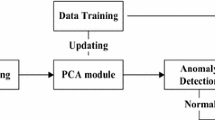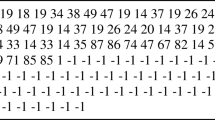Abstract
With the increasing complexity of Internet applications, traditional software architectures have been unable to support the pressure of system access brought about by user growth. Distributed systems have gradually become the mainstream architecture, and messaging has become a widely adopted model. Akka is a distributed framework based on the Actor message communication model. At present, the fault and anomaly detection for the Actor system is mainly to capture the anomaly in the code writing, it is difficult to decouple from the program, so an algorithm using kernel principal component analysis algorithm based on message monitoring is proposed to detect anomaly on Actor system. In this paper, we obtain the message of Actor system by using AspectJ’s slicing of the byte code injection of Java code, and we can use Kernel Principal Component Analysis algorithm to perform data dimension reduction and feature extraction through nonlinear mapping. Then the k-means algorithm was used for cluster analysis. The LOF (local outlier points factor) algorithm was used to compare the density of each point p and its neighborhood points to determine abnormal points. Finally, we took the spider program based on the Actor model as a case to collect data and do the experiment, which verified the validity and rationality of the method.
Access this chapter
Tax calculation will be finalised at checkout
Purchases are for personal use only
Similar content being viewed by others
References
Chen, G.L., Zhong, G.: Study on parallel computing. J. Comput. Sci. Technol. 21(5), 665–673 (2006)
Zhao, Y.: On conversion mechanism of asynchronous communication message based on time decoupling in distributed object-oriented middleware. Comput. Appl. Softw. 25(10), 160–162 (2008)
Hewitt, C., Bishop, P., Steiger, R.: A universal modular ACTOR formalism for artificial intelligence. In: International Joint Conference on Artificial Intelligence, pp. 235–245 (1973)
Zhang, X.W., Jia, X.Y., Chang, L., Liu, Q.C., Hu, X.H.: Parallel dynamic symbolic execution method based on actor model. J. Chin. Comput. Syst. 39(1), 12–16 (2018)
Wang, Z.B., Li, C.Y.: A survey of the technique for software fault diagnosis. Microcomput. Inf. 26(34), 161–163 (2010)
Sun, T.: Data stream outlier detection study based on time series analysis. University of Electronic Science and Technology of China, Xi’an (2016)
Erfani, S.M., Rajasegarar, S., Karunasekera, S., Leckie, C.: High-dimensional and large-scale anomaly detection using a linear one-class SVM with deep learning. Pattern Recogn. 58(C), 121–134 (2016)
Chen, F., Liu, Z., Sun, M.T.: Anomaly detection by using random projection forest. In: IEEE International Conference on Image Processing, pp. 1210–1214 (2015)
Lahrache, A., Cocconcelli, M., Rubini, R.: Anomaly detection in a cutting tool by K-means clustering and support vector machines. Pol. Towarz. Diagn. Tech. 18(3), 21–29 (2017)
Yang, R., Jin, D.H., Gong, Y.Z., Ma, Y.: Static analysis method for detecting null pointer deference in Java. J. Tsinghua Univ. (Sci. Technol.) 51(s1), 1509–1514 (2011)
Song, D.H., Chen, E.H.: A call-chain-based static data race detection algorithm for java program. Ship Electron. Eng. 33(12), 59–63 (2013)
Wang, D., Yang, M., Zhou, X.: An object-centric concurrency bug detection framework for Java. J. Chin. Comput. Syst. 34(06), 97–102 (2013)
Yu, Q., Jiang, S.J., Wang, X.Y., Ju, X.L., Dong, Q.J.: Detection and measurement method of memory leaking objects. J. Front. Comput. Sci. Technol. 8(8), 978–988 (2014)
Ma, X., Li, Q.S., Chen, P.G.: Basic information needed in reversing-engineer by Aspect. Comput. Syst. Appl. 20(02), 63–67 (2011)
Tipping, M.E., Bishop, C.M.: Probabilistic principal component analysis. J. R. Stat. Soc. 61(3), 611–622 (2010)
Sheriff, M.Z., Karim, M.N., Nounou, M.N., Nounou, H., Mansouri, M.: Fault detection of nonlinear systems using an improved KPCA method. In: International Conference on Control, pp. 0036–0041 (2017)
Li, Q., Zhou, X.S.: Multivariate time series anomaly detection method based on KPCA. Comput. Measur. Control 19(4), 822–825 (2011)
Fezai, R., Jaffel, I., Taouali, O., Harkat, M.F., Bouguil, N.: Online process monitoring based on Kernel method. In: International Conference on Control, pp. 236–241 (2017)
Dave, T.: OpenFlow: enabling innovation in campus networks. ACM SIGCOMM Comput. Commun. Rev. 38(2), 69–74 (2008)
Farias, F.N.N., Salvatti, J.J., Cerqueira, E.C., Abelem, A.J.G.: A proposal management of the legacy network environment using OpenFlow control plane. In: Network Operations and Management Symposium, vol. 104, no. 5, pp. 1143–1150 (2012)
Hotelling, H.: Analysis of a complex of statistical variables into principal components. J. Educ. Psychol. 24(6), 417–520 (1933)
Zhai, R.: Virtual machine exception detection based on nearest neighbor algorithm. Netw. Secur. Technol. Appl. (6), 55-56 (2016)
Meng, H.D., Ren, J.P.: Clustering algorithm based on cloud computing platform. Comput. Eng. Des. 2990–2994 (2015)
Breunig, M.M.: LOF: identifying density-based local outliers. In: ACM Sigmod International Conference on Management of Data, vol. 29, no. 2, pp. 93–104 (2000)
Author information
Authors and Affiliations
Corresponding author
Editor information
Editors and Affiliations
Rights and permissions
Copyright information
© 2018 Springer Nature Switzerland AG
About this paper
Cite this paper
Wang, C., Wang, J., Wang, C., Shen, Q. (2018). Actor Model Anomaly Detection Using Kernel Principal Component Analysis. In: Cheng, L., Leung, A., Ozawa, S. (eds) Neural Information Processing. ICONIP 2018. Lecture Notes in Computer Science(), vol 11304. Springer, Cham. https://doi.org/10.1007/978-3-030-04212-7_48
Download citation
DOI: https://doi.org/10.1007/978-3-030-04212-7_48
Published:
Publisher Name: Springer, Cham
Print ISBN: 978-3-030-04211-0
Online ISBN: 978-3-030-04212-7
eBook Packages: Computer ScienceComputer Science (R0)




